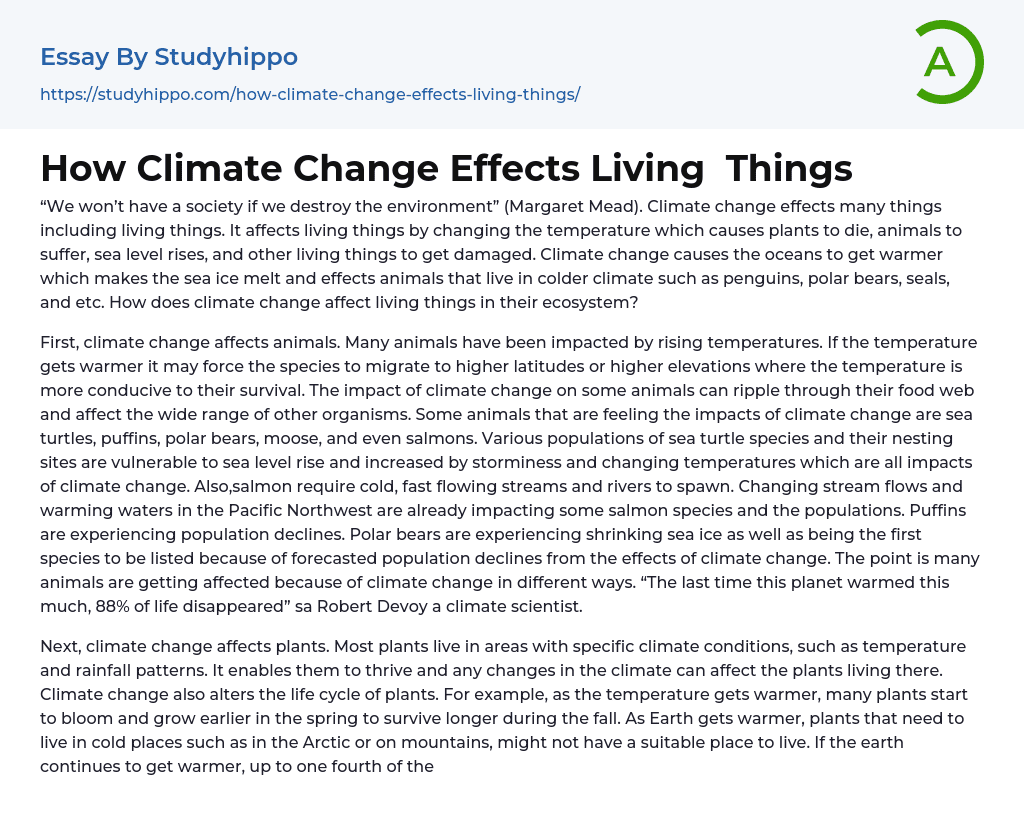“We won’t have a society if we destroy the environment” (Margaret Mead). Climate change effects many things including living things. It affects living things by changing the temperature which causes plants to die, animals to suffer, sea level rises, and other living things to get damaged. Climate change causes the oceans to get warmer which makes the sea ice melt and effects animals that live in colder climate such as penguins, polar bears, seals, and etc. How does climate change affect living things in their ecosystem?
First, climate change affects animals. Many animals have been impacted by rising temperatures. If the temperature gets warmer it may force the species to migrate to higher latitudes or higher elevations where the temperature is more conducive to their survival. The impact of climate change on some animals can ripple through their food web a
...nd affect the wide range of other organisms. Some animals that are feeling the impacts of climate change are sea turtles, puffins, polar bears, moose, and even salmons. Various populations of sea turtle species and their nesting sites are vulnerable to sea level rise and increased by storminess and changing temperatures which are all impacts of climate change. Also,salmon require cold, fast flowing streams and rivers to spawn. Changing stream flows and warming waters in the Pacific Northwest are already impacting some salmon species and the populations. Puffins are experiencing population declines. Polar bears are experiencing shrinking sea ice as well as being the first species to be listed because of forecasted population declines from the effects of climate change. The point is many animals are getting affected because of climate change in different ways. “The
last time this planet warmed this much, 88% of life disappeared” sa Robert Devoy a climate scientist.
Next, climate change affects plants. Most plants live in areas with specific climate conditions, such as temperature and rainfall patterns. It enables them to thrive and any changes in the climate can affect the plants living there. Climate change also alters the life cycle of plants. For example, as the temperature gets warmer, many plants start to bloom and grow earlier in the spring to survive longer during the fall. As Earth gets warmer, plants that need to live in cold places such as in the Arctic or on mountains, might not have a suitable place to live. If the earth continues to get warmer, up to one fourth of the plants could become extinct within one hundred years. How can climate change affect the metabolism in plants? Well the direct and indirect climate change effects on photosynthesis and transpiration. Climate change also affects plants by increasing CO(2) concentration can increase photosynthetic rates. This is especially pronounced for C(3) plants, at high temperatures and under water limited conditions. Every plant and animal play a part in the ecosystem. For example, as a source of food, a pollinator, a predator, and a source of shelter. Losing even one specie or plant can affect many others.
Finally, climate change also affects sea levels and sea ice levels. Sea levels are rising as the oceans are getting warm. The ice melts and the water expands. Sea levels have already risen a foot and by the end of the century it can be more. Earth's climate is causing sea levels to rise in two
different ways. Warmer air temperature is causing glaciers and land ice to melt. As the melt water flows into the ocean the total amount of water causes the sea level to rise. Also, as ocean water warms it then expands and pushes the water farther up along our shores. Sea level rose in the last one hundred fifty years. It was dominated by retreat of glaciers and expansion of the ocean. Since 1922, sea levels in Boston Harbor have risen by 10.4 inches. There are two important reasons on why sea levels are rising faster along the New England coast than elsewhere on the planet. Our land is slowly settling, relative to sea level. The second reason is that circulation currents in North Atlantic may be changing. Sea levels are projected to rise and additional 2.4 to 7.4 feet by 2100 along the northeastern coast depending on the rate of future greenhouse gas emissions. Warmer water temperatures delay ice growth in the fall and winter. The ice melts faster the following spring and exposes the dark ocean water for a longer period the following summer. The changes in the amount of sea ice can disturb normal ocean circulation and leading it to changes in global climate.
In conclusion, climate change has been affecting living things in their ecosystem. Animals, plants, sea ice levels, and sea levels are getting affected by climate change. Climate change is causing sea levels to rise as well as animals to ache and plants to die. Animals are also impacted by rising temperatures. “Nothing is more important to this society than preserving its natural capital. People need nature to survive, to thrive”(Harrison
Ford).
- Weather essays
- Seasons essays
- Meteorological Disaster essays
- Precipitation essays
- Spring essays
- Winter essays
- Air Pollution essays
- Carbon Dioxide essays
- Climate essays
- Deforestation essays
- Ecology essays
- Endangered Species essays
- Environmental Issues essays
- Environmental Protection essays
- flood essays
- Greenhouse Gas essays
- Hurricane essays
- Nature essays
- Pollution essays
- Renewable Energy essays
- Sustainability essays
- Tornado essays
- Traffic essays
- Tsunami essays
- Water Pollution essays
- Animal Welfare essays
- Climate Change essays
- Conservation essays
- Global Warming essays
- Plastic essays
- Recycling essays
- Waste Management essays
- Zoo essays
- Environmental Disaster essays
- Sustainable Development essays
- Atmosphere essays
- Biodiversity essays
- Coral Reef essays
- Desert essays
- Earth essays
- Ecosystem essays
- Forest essays
- Lake essays
- Natural Environment essays
- Ocean essays
- Oxygen essays
- Rainbow essays
- Sea essays
- Soil essays
- Volcano essays




